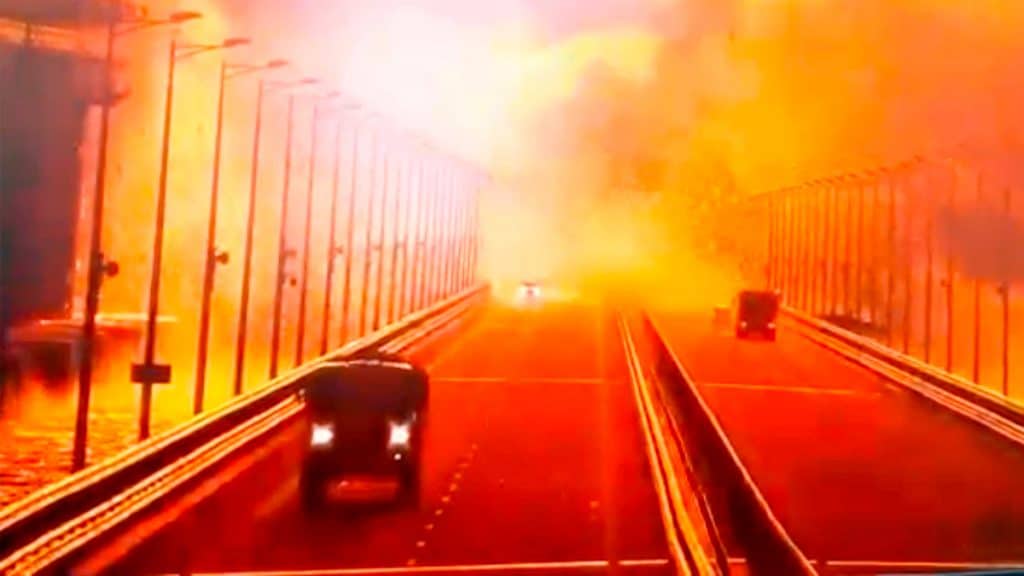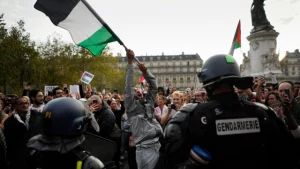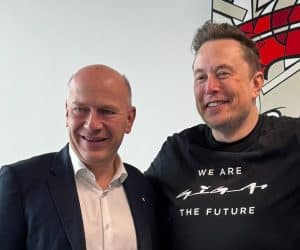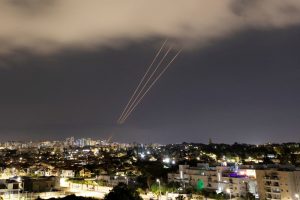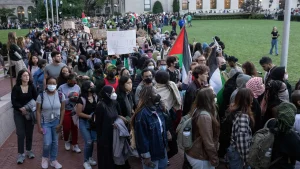The first full day of Russian president Vladimir Putin’s 71st year began with some very bad news. On the morning of Saturday, October 8, the day after his birthday, an explosion partially destroyed the bridge over the Kerch Strait that connects mainland Russia to the Crimean Peninsula.
The bridge is a strategic piece of infrastructure: in peacetime, it connects the Sea of Azov with the Black Sea, and Russia uses it to access the Mediterranean; and in times of war, like now, it is the main route for refueling and resupplying Russian troops in eastern and southeastern Ukraine. That explains why it is among the positions the Russian army most aggressively defends.
The military impact is undeniable, and complicates Russia’s already vulnerable logistics. It is also a blow to the army’s morale. The Kremlin considers the bridge — which Putin himself opened in 2018, driving a truck across it — to be a symbol of Russia’s prestige and its great power ambitions. (Notably, neither Hitler’s Wehrmacht nor the Red Army were able to cross the strait during World War II).
Who carried out the attack is unclear; there is much speculation, and the different hypotheses include a dissident faction of the Russian army itself. The Ukrainian government did not officially claim responsibility, but did celebrate the attack and, off the record, acknowledged the fingerprints of its special units. Those irregular forces had already been carrying out terrorist attacks behind Russian lines in Crimea and elsewhere, perhaps anticipating the current combination of conventional and asymmetric warfare that could continue indefinitely.
While six months into the war military analysts were speculating as to whether the Russian army had reached its “culminating point,” and would thus move to a mostly defensive position, today the focus is on what the “culminating point” of the Ukrainian counteroffensive will be.
This attack at the gates of Crimea is part of a series of Russian tactical setbacks ever since Ukrainian forces, armed by the United States and NATO, decided to launch its ongoing counteroffensive that began in mid-August. This offensive began with driving Russian troops out of the northeastern city of Kharkiv and continued toward the south, with the apparent goal of retaking the city of Kherson. Ukrainian president Volodomyr Zelenskyy has used this offensive to amplify Ukraine’s war propaganda (“Ukraine can win”) and push the Western powers — primarily the United States — to improve the offensive quality of the weapons generously provided by the Pentagon. However, the Biden administration has yet to cross the “red line” of arming Ukraine with precision weaponry that can reach Russian territory.
So far, President Putin has responded to this offensive with an incremental escalation of conventional military resources. On September 21, he announced the partial mobilization of reservists (300,000 is the initial objective). And on September 30, he decreed the annexation of four territories in southeastern Ukraine: Lugansk, Donetsk, Kherson, and Zaporizhia. However, the almost immediate loss of major cities such as Lyman shows an obvious disparity between political strategy and military reality, as the Russian army clearly lacked the capacity to consolidate the annexed positions.
The political implication of this annexation is that, in theory, the Kremlin would consider an attack in the region as a direct NATO attack on Russian territory. But between the theory and concrete military action lies a set of mediating factors. Hence, further attacks such as those launched in Lyman and Kherson will not automatically trigger a Russian attack on any NATO member country, as some analysts have speculated.
Putin’s allusion to the use of non-conventional weapons (“I’m not bluffing,” he said), faced with what he may consider to be an existential threat from NATO against Russia, has renewed fears that the war could turn into a nuclear conflict. The U.S. government jumped on these statements, undoubtedly for propaganda purposes. Incidentally, Putin played a similar card by recalling that the only country that had broken the “nuclear taboo” was none other than the United States, with its bombings of Hiroshima and Nagasaki.
At a Democratic Party fundraiser, Biden spoke of nuclear “Armageddon” and said the threat was the most serious since the 1962 Cuban Missile Crisis. Biden’s goal was probably to warn the Russian government so that it would give up on the very idea of using such weapons. And while U.S. military intelligence has acknowledged that it has no evidence Putin is planning a nuclear attack, Biden’s alarmist prophecy fueled discussions among the most hawkish sectors of the administration of an opportunity for “regime change” in the Kremlin — a recipe for extreme escalation.
The likelihood of such an attack is low, for now, and there is still a lot of room on both the Russian and the Ukrainian sides to escalate without resorting to unconventional means. The very inclusion of the nuclear threat in official discourse, however, highlights the growing magnitude of the war, which has increasingly become a “proxy war” between the United States and NATO on the one hand and Russia on the other.
The Western press has been quick to define the Ukrainian offensive as a turning point, reflecting Russia’s weakness. But, as we know, information is part of the war machine to win “hearts and minds” and avoid the “war fatigue” so dreaded by NATO governments. And while the weaknesses of Russia’s strategy are starkly exposed (as evidenced by its military setbacks), the difficulties of Ukraine’s war effort are being masked by the military and economic support provided by U.S. and European imperialism.
The actual situation is impossible to know for sure. After months of relative stagnation, with a very slow and tortuous advance by the Russian army to the southeast, the Ukrainian offensive has changed the dynamics and quickened the war’s pace — but not enough to end the conflict. The Ukraine/NATO side is in no position to concede, but neither is Russia, which is far from having been defeated. According to “realist” political scientist John Mearsheimer, this is what leads to a logic of escalation, which can be catastrophic even if it does not involve nuclear weapons.
In the near term, we are witnessing a new, quite fluid political-military situation. This is a transitional phase characterized by the stress between two conflicting and time-related objectives: on the one hand, Ukraine’s (and NATO’s) haste to advance as much as possible before the weather begins to wreak havoc and Russia manages to put new troops on the ground; and on the other, Russia’s need to prolong the situation as much as possible, in the hope that the winter weather will complicate Ukraine’s military logistics and, above all, divide the front of Western powers — particularly Europe, the current epicenter of the energy crisis. Both possibilities mean the conflict will continue for at least a few more months.
The Other Battle Fronts
The military setbacks have led to bitter disputes within the Russian state apparatus and Putin’s Bonapartist regime. In recent months, critics in the most pro-war, nationalist sectors have become more vocal on a range of platforms, from television to social media, condemning the military commanders (and ultimately the Kremlin) for what they view as a half-hearted strategy that is leading to defeat. These sectors, whose spokesmen are the Chechen leader Ramzan Kadyrov and the oligarch Yevgeny Prigozhin, founder of the Wagner mercenary group, are on a crusade against the defense minister, Sergei Shoigu, who is in an increasingly vulnerable position. These disputes have created tension among the war’s political leaders.
Mobilizing reservists is the other source of domestic conflict for Putin. Until September 21, Putin had a two-prong policy for preserving the consensus on his “special military operation” among the general population: a huge crackdown on opponents (with prison sentences of up to 15 years) coupled with efforts to prevent the war from affecting the daily lives of Russian citizens, particularly those in the big-city middle class, who couldgo on with their lives almost normally — except for a few international luxury stores, along with McDonald’s golden arches, shutting down. The mobilization of reservists put an end to this silent consensus. Thousands of Russians (some have calculated as many as 200,000), especially those with purchasing power and other resources, have fled to avoid being called up. Most notable were the scenes of unrest and even outright rebellion at recruitment centers in the Russian Federation’s most neglected republics, such as Dagestan, from which a disproportionate number of soldiers are enlisted.
According to some surveys cited in a recent Le Monde diplomatique article, the regime maintains a base of support, at least for now, because middle-class sectors, students, professionals, and anyone lacking basic military training have been exempted from this partial mobilization, and thanks to Putin’s patriotic defensive rhetoric (“Russia is under threat by the West”) used to justify this turning point in the war since the annexation. The military setbacks, however, coupled with the economic sanctions, will undoubtedly have a direct impact — not to mention, of course, a defeat, which, as Gramsci pointed out, inevitably turns into a crisis of political and state authority, particularly when the ruling class has called on the masses to support this failed enterprise.
This is what Biden and the Western powers are betting on, although there is a sector of imperialism itself pushing for a negotiated solution that prefers keeping Putin in power rather than facing the chaos and lack of governability of the planet’s second-ranked nuclear power.
The Energy War, Geopolitical Disputes, and Class Struggle
If, strictly speaking, every war is waged beyond the military sphere, then the war in Ukraine’s battlefield is global and encompasses the economy, politics, geopolitics, and even class struggle.
Russia’s invasion and the war it is waging in Ukraine have caused a geopolitical earthquake that has given rise to two large blocs that, in a way, replicate the two sides of the Cold War. The Western alliance led, by the United States through NATO, backs Ukraine and has been joined by allies such as Japan and Australia. On the other side, there is an uneasy alliance — but an alliance nonetheless — between China and Russia, along with several major regional powers such as India that, without openly supporting Russia’s war in Ukraine, have not aligned themselves with the United States and, in their own way, are closer to the Eurasian bloc. The Shanghai Cooperation Organization summit held in late September in Samarkand, Uzbekistan, exposed both the contradictions of this informal bloc — with both Xi Jinping and Indian prime minister Narendra Modi expressing their concerns about the war to Putin — and its objective convergence of interests, especially of those marginalized from the U.S. “neoliberal order.”
In recent weeks, two serious events have highlighted the Ukraine war’s strategic consequences. The first was the attack on the Nord Stream 1 and 2 gas pipelines, which transport Russian gas to European Union countries. No one claimed responsibility, and the United States and Russia have openly accused each other of sabotage. Meanwhile, a former official of the Polish government tweeted and then deleted a photo of the smoking pipeline with the caption, “Thank you, America.” This very foggy episode shows the relative ease of carrying out submarine attacks, particularly in the Baltic Sea, which poses a risk to a large network of underwater infrastructure.
The other significant event was the OPEC+ decision to cut its daily production quota in order to raise global crude oil prices — at the initiative of Saudi Arabia and Russia. This measure by the cartel of oil-exporting countries) was a response to the EU’s decision (at U.S. behest) to cap the price of Russian oil, thus reinforcing its economic sanctions.
Haitham Al Ghais, OPEC’s secretary-general said the motivation is exclusively monetary and explained it as a precautionary measure to prevent prices from plummeting in the event of a recession or crisis (like in 2008).
“Everything has a price,” he said. “Energy security has a price as well.”
The geopolitical significance is obvious. OPEC’s decision undoubtedly benefits Putin and underscores the growing U.S. inability to align its fractious allies, like the Saudi Arabian monarchy. The White House had been lobbying to avoid the measure, which makes the sense of humiliation even more pathetic, while at the same time complicating Biden’s efforts to lower inflation (gas prices are particularly sensitive to the OPEC move) in the race against time to the midterm elections.
Its consequences for the global economy are eloquent: the measure increases inflation and deepens the energy crisis that especially affects the EU, leading to a rise in tensions and internal disputes. The Prague summit of the “European Political Community” — a new informal group proposed by the EU, made up of all of the countries on the continent except Russia and Belarus — became the scene of these disputes, with Poland and other Eastern countries accusing Germany of “selfishness” for its energy policy, which includes millions in subsidies. And longstanding crises like Brexit were also back on the agenda. Ultimately, what is creating tension in the EU is the renewed U.S. leadership of the Western powers through NATO, which, as the German sociologist Wolfgang Streeck pointed out, has set aside its ambitions of what French president Emmanuel Macron calls “strategic sovereignty” by turning the EU into a civilian “auxiliary” of NATO.
The energy crisis and, more generally, the war’s consequences, directly affect the standard of living of millions around the world, in a context of high inflation and growing recessionary trends. This situation is giving rise to a tumultuous scenario in which the crisis of traditional bourgeois parties and social and political polarization are coupled with an incipient but persistent tendency towards greater class struggle. Ultimately, the exhaustion of the neoliberal globalizing hegemony and the crisis of liberal democracy have led to a historical stage marked by crises, imperialist rivalries, and wars, as well as revolutionary prospects.
First published in Spanish on October 9 in Ideas de Izquierda.
Translation by Marisela Trevin


